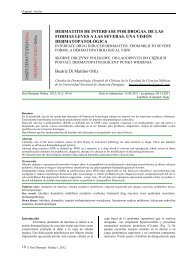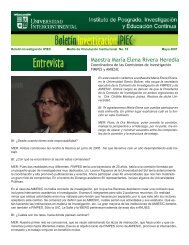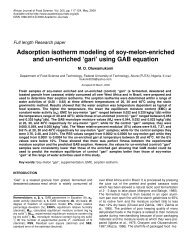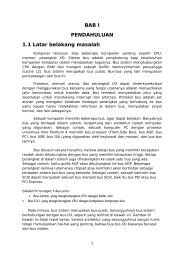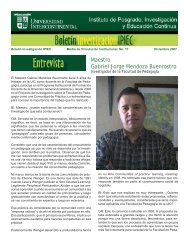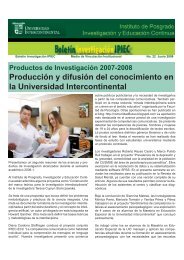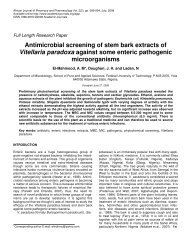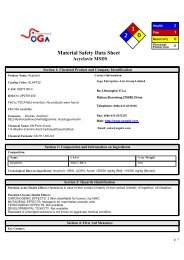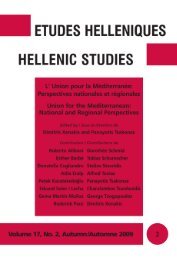wheat composite flour and bread - Science Stage
wheat composite flour and bread - Science Stage
wheat composite flour and bread - Science Stage
Create successful ePaper yourself
Turn your PDF publications into a flip-book with our unique Google optimized e-Paper software.
090 Afr. J. Food Sci.<br />
Table 5. Scores for sensory attributes of <strong>bread</strong> samples from the <strong>composite</strong> <strong>flour</strong>.<br />
Sample code<br />
Attributes<br />
Crust<br />
colour<br />
Crumb<br />
colour<br />
Crumb grain<br />
texture<br />
Quality attributes<br />
Symmetry Taste Aroma Overall<br />
acceptability<br />
A 5.3 a 5.3 a 5.4 a 5.8 a 4.7 a 4.3 b 5.8 a<br />
B 5. 3a 5.2 a 5.3 a 5.6 a 4.8 a 4.6 a 5.6 a<br />
C 4.4 b 4.3 b 4.8 b 5.4 a 5.3 a 5. 0a 5.5 a<br />
D 4.0 b 4.0 b 4.1 c 4.7 b 4.9 a 5.0 a 4.9 b<br />
E 3.6 b 3.6 b 3.5 c 4.3 b 4.8 a 5.0 a 4.6 b<br />
F 2.8 c 3.0 c 3.0 c 3.4 c 5.1 a 5.2 a 3.4 c<br />
Means followed by different superscript within a column are significantly different (p0.05)<br />
A, B, C, D, E, <strong>and</strong> F are as defined in Table 1.<br />
Table 4. Loaf volume (100 g dough) of <strong>bread</strong><br />
produced from the <strong>composite</strong> <strong>flour</strong> samples.<br />
Samples Volume (cm 3 )<br />
A<br />
350 f<br />
B<br />
315 e<br />
C<br />
290 d<br />
D<br />
240 c<br />
E<br />
175 b<br />
F<br />
145 a<br />
Means followed by different superscript within a<br />
column are significantly different (p0.05) A, B,<br />
C, D, E, <strong>and</strong> F are as defined in Table 1.<br />
in Table 4, with 100% <strong>wheat</strong> <strong>bread</strong> having the highest<br />
value. This result showed reduced loaf volume as proportion<br />
of tigernut increased in the <strong>flour</strong> mixes. However,<br />
volume of <strong>bread</strong> produced from 90:10 <strong>wheat</strong>- tigernut<br />
mixes was comparable to those produced from pure<br />
<strong>wheat</strong> <strong>flour</strong>.<br />
Sensory properties<br />
The mean sensory scores for the <strong>bread</strong> produced from<br />
the <strong>composite</strong> <strong>flour</strong> are presented in Table 5. The result<br />
of the sensory evaluation revealed that <strong>bread</strong> from pure<br />
<strong>wheat</strong> <strong>flour</strong> <strong>and</strong> those produced from <strong>composite</strong> <strong>flour</strong> with<br />
10% <strong>and</strong> 20% tigernut <strong>flour</strong> were rated alike in almost all<br />
the quality attributes evaluated indicating the feasibility of<br />
adding tigernut to baked goods. This result suggests the<br />
potential application of tigernut <strong>flour</strong> either as full fat or<br />
defatted <strong>flour</strong> in baking industry.<br />
Conclusion<br />
Inclusion of tigernut <strong>flour</strong> in <strong>wheat</strong> <strong>flour</strong> at levels of 10 to<br />
50% resulted in notable increase in fibre <strong>and</strong> ash contents<br />
while protein content decreased. The significant<br />
increase in the fibre content (167 to 967%) could be<br />
nutritionally advantageous in Nigeria, where white <strong>bread</strong><br />
is one of commonest staples among all classes of people.<br />
Evaluation of the viscoelastic properties of dough<br />
from the <strong>composite</strong> <strong>flour</strong>, physical <strong>and</strong> sensory properties<br />
of <strong>bread</strong> revealed that a 10% <strong>wheat</strong> <strong>flour</strong> substitution with<br />
tigernut <strong>flour</strong> yielded <strong>bread</strong> product that was similarly<br />
rated with that produced from pure <strong>wheat</strong> <strong>flour</strong>. From the<br />
result of this study, it could be suggested that tigernut<br />
<strong>flour</strong> might find useful application in the Nigerian baking<br />
industry.<br />
REFERENCES<br />
AACC (1984). Approved methods of analysis. St. Paul. Minnesota: The<br />
American Association of Cereal Chemists p.1298<br />
AOAC (1990). Association of Official Analytical Chemists, 15 th Edition.<br />
Wincosin U.S.A. p. 1298<br />
Adeyemi IA (1988). A research Note: Ogi quality sorghum dry milled<br />
from fermented Sorghum Grains. J. Cereal Sci. 53: 640-642.<br />
Addy EO, Eteshola E (1984). Nutritive value of a mixture of Tigernut<br />
tubers <strong>and</strong> baobab seeds. J. <strong>Science</strong>, Food Agric. 35: 437-440.<br />
Anderson JW, Smith BM, Gustafson NJ (1994). Health benefits <strong>and</strong><br />
practical aspects of high fibre diets. Ame. J. Clinical Nutr. 59:<br />
1242S-1247S.<br />
Alobo AP, Ogbogo PO (2007). Selected properties of tigernut starch as<br />
affected by physical <strong>and</strong> chemical modifications. Proceeding of the<br />
31 st annual NIFST conference, Abuja, Nigeria. 22 nd – 25 th October,<br />
2007.<br />
Basman A, Koksel H (2003). Utilization of transgluranase use to<br />
increase the level of barley <strong>and</strong> soy <strong>flour</strong> incorporation in <strong>wheat</strong> <strong>flour</strong><br />
<strong>bread</strong>s. J. Food Sci. 68(8): 2453-2460.<br />
Bokanga M (1995.) Cassava: Opportunity for food, feed, <strong>and</strong> other<br />
industries in Africa. In: Agbor T, Egbe A, Brauman Griffon D, Treche<br />
S (eds.) Orstom. pp. 557-569.<br />
Bosch L, Alegria A, Farre R (2005). RP-HPLC Determination of tigernut<br />
<strong>and</strong> Orgeat amino acid contents. Food Sci.Technology Inter. 11(1):<br />
33-40.<br />
FAO/WHO (1985). Energy <strong>and</strong> Protein requirement, Geneva. Report of<br />
a joint FAO/WHO/UNU expert consultation. WHO Technical report<br />
Series No. 724.<br />
Chevallier A (1996). The Encyclopedia of medicinal plants. Dorling<br />
Kindersley. London. ISBN. 9: 980751-303148.<br />
Chinma CE, Ocheme OB (2007). Effect of simple wetting method for<br />
cyanide reduction on the physico-chemical properties of cassava<br />
<strong>flour</strong>. Proceeding of the 31 st annual NIFST conference, Abuja, Nigeria.<br />
22 nd – 25 th October, 2007.<br />
Chopra RN, Nayar SL, Chopra IC (1986). Glossary of Indian medicinal<br />
plants (Including the supplement). Council of scientific <strong>and</strong> industrial<br />
research, New Delhi. pp. 18-30.<br />
Dhingra S, Jood S (2002). Physico-chemical <strong>and</strong> nutritional properties



